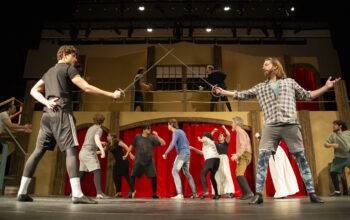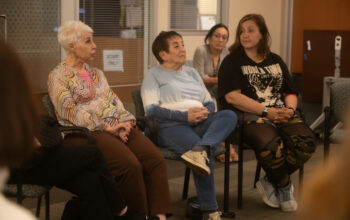Andre Fuller/Roundup
Her vibrant personality screams “excitement” as every word is carefully thought through.
She couldn’t help but flail her arms to help the precise words sound like a beautiful chorus.
Barely five feet tall, you would never know she has the heart of giant. A big heart comes second nature to art teacher Ramela Abbamontian, for it’s her upbringing that makes this so easy for her to have.
Growing up in a loving Armenian family, having a strong family core was the most important thing to Abbamontian and her two younger brothers.
Her work ethic starts with her father.
Losing his father at the age of 13, he was put into the same role at an early age, taking care of his brothers and sisters, as well as constantly working. So when Abbamontian and her siblings were born, learning how to balance out family and work was stressful at times, but he would make sure he always had time for his children.
“I had a beautiful childhood. I love, honored and respected my parents. I know I had parents that adored us,” Abbamontian said. “I know how busy my dad was, but he would never say he didn’t have time for us. He would come home late at night and he would play games with us.”
Abbamontian translates her dad’s commitments to her profession.
Investing a lot of time in her students, Abbamontian’s passion can be matched, but never outdone.
There was a student who lost her job and had to take on two others that didn’t pay nearly the amount the original did.
Abbamontian felt the student’s pain.
“It broke my heart. I came home and I said (to my husband), ‘Honey, it’s just not fair.’ Here’s this poor girl, she’s trying to get books for this and that and it was hard,” Abbamontian said. ” I just want the students to know that I care.”
The care level for her students and family is the same, but in a different sense. A wife and mother of two girls, Grace and Lily, Abbamontian makes sure her time is evenly distributed among work and family, as challenging as it might be.
Since love and art comes from the heart for Abbamontian, learning how to deal with the troubles of balancing family and work becomes easier for her.
Designating Monday through Thursday mornings and afternoons for work, then weekday evenings and weekends for the family, Abbamontian is able to maintain happiness.
“I’ll go to work and I’m really happy at work, then I go home and I’m really happy at home. So my kids get a working mom, who’s a happy mom because she loves her job—it’s rewarding beyond words,” she said.
The level of happiness is helped by Jimmy, the “world’s best husband” and her complete opposite.
She wouldn’t have it any other way.
“It’s a beautiful thing because sometimes when I freak out, he balances me out. He’ll bring me back and say, ‘Honey, it’s ok’. He’s never lost his temper. He’s just that solid, very strong man that believes we can do anything together,” Abbamontian said.
The scholar and famed social art historian Albert Boime, Abbamontian’s old professor, helped pave the way for her passion. The main reason she went to the University of California, Los Angeles was because professor Boime was a humbling man who helped her become the person and teacher that she is today.
“He was so humble. He was brilliant, but right down with the students. He cared so much about them. I saw how much he loved them. He would jump on stage, showing us something, and then he would jump back down,” she recalled. “The passion for the students and the passion for teaching, while at the same time being humble about it, that’s what I saw.
“So if I can go to graduate school and become like that and become a professor that is humble and totally involved with the students, that’s what I want,” she said.
Translating that passion for arts and teaching came from the Getty Museum in Los Angeles. Training there in 1997, she learned from educators, curators, observers and other people teaching the arts can serve the community.
“So it wasn’t like a medical service, but an intellectual service that I can provide. It was a way to build bridges, a way for us to understand one another and a way to understand the world,” Abbamontian said. “So I thought maybe there is a future out there.”
Art, for Abbamontian, isn’t just in books. Taking her students to museums and traveling to various parts of the world to see art is a must for Abbamontian and her students.
“I took my book with me [to Italy] and I saw all the things in the book as two-dimensional slides. So when I went there, I saw how people were interacting with it,” Abbamontian said, eyes lit up. “Art wasn’t static or isolated, it was part of people’s lives.”
Abbamontian wants the art to affect her students’ lives like it did hers. So when teaching her students, Abbamontian tries to relate the art back to them.
“The question becomes, ‘Why do I have to know this?” she explained. “My goal for my students is to make them critical consumers of their visual culture. So when they see an advertisement, I want them to know how that advertisement is set up to make them want to buy that product.”
Her goal is well translated as her passion rubs off on her students.
“She’s a great professor, very intellectual and challenging,” said Kyle Harris, business major. “This (Art 109) class is very beneficial. I would definitely take this class at a four-year university.”
Growing up with a close family whose members believed in one another, Abbamontian tries to create that same interaction with her students.
“I believed in myself because I had people that believed in me,” she said. “I think part of what students don’t have is that ‘I believe in you, you can do this.'”
—
afuller.roundupnews@gmail.com

Ramela Abbamontion, professor of Art History, stands outside her office in Village 8341 after showing a video in her Art 109 class. (Petrina Roudebush / Roundup)



